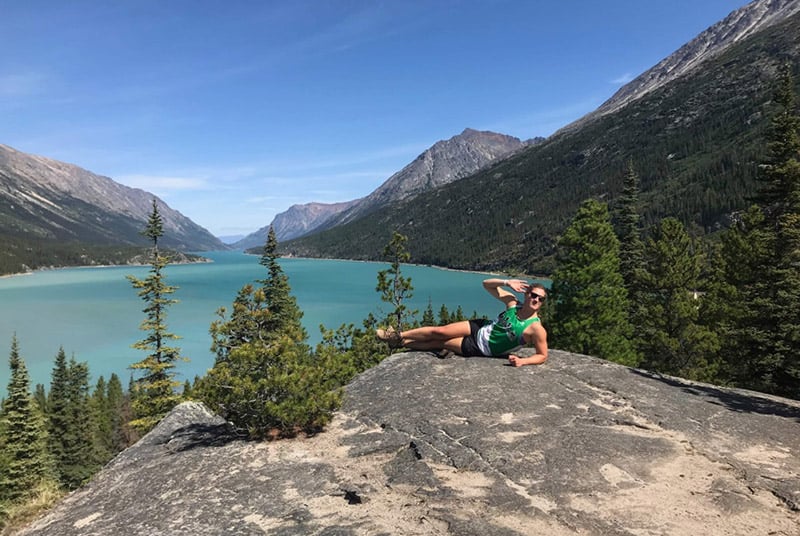“Are you Applying for the Adventure Team this year?”…
“Where is it again? It’s in Banff or something isn’t it?”…
“Dude… It starts in the Yukon and then you go to Alaska and then Hike to BC before returning to the Yukon”…
“…oh shit.” …
If you know me, you know I’m very active and involved in many different things, and I can’t quite sit still. That being said – I’m not very adventurous. I do a lot of things, but within my comfort zone, and I’m (mostly) happy with that. I know what I am doing, what I’m eating, and who I’m doing these things with, almost every day, in the same places. Part of this may have been formed as habits and routines because of my Diabetes, simply due to the fact that this makes control of my blood sugars a hell of a lot easier. Routine is easy and predictable.
Predictable….I like this. I like knowing.
Disclaimer: Please check out CIM’s Partners Page to learn more about the companies we work with. It’s important for CIM to recognize and to disclose that our writing may be biased based on the fact that the Dexcom provides sponsorship and support to CIM. We work hard to get information into the hands of the diabetes community whenever we feel it may help people live life without limits. We also felt it was important to note that the article of this author is a Dexcom Ambassador, however, she was not compensated by Connected in Motion nor Dexcom for this piece.
Adventure Trekking with Dexcom

The predictive feature on the Dexcom gives users a head’s up of where blood sugars are heading so they can be corrected before it’s a larger issue.
This is why I immediately fell in love with the CGM device, Dexcom, the minute I heard about it. I can always know what my blood sugar is, and it helps me to predict high and low blood sugars with its indication arrows if blood sugars are rising and falling, as well as providing alarms to my phone or receiver when my blood sugars hit a specified high or low target. I can see it on my phone, and Apple Watch, all the time. This is reassurance and comfort for me, 24/7. I like this.
Inevitably, however, even with the routine I have that I like, and the people and things that I like, I couldn’t help but frequently notice the things that other people are doing and experiencing that seem to be a bit bigger in life than what I’m doing. Those things that Connected In Motion encourages us to do, like: travel the world, explore the outdoors in a bold and adventurous way, and dabble in new experiences. I wanted to do this, but I didn’t know what, or how, or when.
I hit a point in my life where I felt stagnant in every single facet and I needed a change. I felt unmotivated and lacking any kind of spark. That routine life I swear by started to consume me a bit, where, even though I had control of my diabetes, I still felt it controlled me because I was too scared to do something that might tip the scales or challenge me.
That’s when I saw CIM’s annual post about the next Adventure Team Trek, which I have always wanted to do, but again…routine and comfort seemed to trump this. And, as any diabetic would, I briefly considered the amount of work it would be to handle this, despite the fact I was doing this with all people with Type 1 Diabetes as well – but then I remembered that I have my Dexcom. My comfort blanket. This gave me that little bit of extra confidence to be ready to do something sporadic and delve into a new and different activity. I knew that I have my Low Alarm set to 4.9 mmol/L, and all I have to do when it hits that is stop and fix it, and continue on with my journey. The best part was when everything was confirmed with the teams, it was evident that many of the other team members were also on some sort of CGM device, the majority being Dexcom.

The rainbow of Dexcom users on different devices, at different levels and settings to suit them and their comfort and needs
This adventure truly was no joke physically and mentally, not to mention that added puzzle piece: diabetes. Over 50km’s and over 4,500 ft of elevation gain during the trek, our bodies had to be properly fueled not only for the activity, but for what could happen with our blood sugars. Sometimes it was a guessing game, but there was a definite reassurance from the Dexcom of knowing in real-time how my actions affected my blood sugars, without having to stop and administer a random finger poke only to see a one-time blood sugar. Low treatments were readily available for if, or when, that alarm went off for low blood sugars.

The red colour indicates blood sugars at a level that the user has chosen to not be desirable, even in the mountains!
It was a diabetes musical on the trail with all of the different sounds, alerts, and warnings coming from our devices, and this… this was music to my ears. Re-assurance that we can be told what’s happening without having to stop or guess.
Additionally, other people in the group were always aware of a blood sugar drop when the alarms went off, and would stop as a collective, and multiple people offered low snacks. Even just having the group all stop together and understand what was going on in this situation, was a great feeling as a diabetic, like you weren’t alone. And it happened at least once, to everyone.
The Dexcom G5 sensor is approved to last 7 days before changing it, which gives an entire week of readings, only having to calibrate twice a day – a lot less than the 7-10 meter readings I used to do before CGM. Changing the sensor is fairly easy, making it convenient to change even on a trail in the Mountains of Alaska. And now, with the new Dexcom G6 officially launched in Canada, there will be zero fingerpricks over 10 days. This is even better news for my next mountain adventure.
Throughout this entire adventure, a group of 12 Type 1 Diabetics bonded almost instantly, starting with our commonalities in the diabetes world, and flourishing into bigger and more important connections. As a group, we were so fortunate to have the technology we did, like Dexcom, that gave us the most important thing that Diabetics often fall short of: Time.
Not having to constantly play the guessing game with sugar levels, and test copious amounts of times, allowed us to experience the more important things.
The views. The views and scenery were unbelievable, and I had time to look and take it in without constantly thinking about my diabetes.
The people and conversations. I was able to listen to everything people were saying, and respond with full attention.
After almost 10 days of being in a completely different environment than what I’m used to, living a different way then I do every day, and with people I had never even met before but I now call good friends of mine, I can honestly say that thanks to the CGM technology of Dexcom, I have never felt so comfortable getting uncomfortable.

Dexcom in the wild. Type 1’s making fresh sensor changes at campsite.
About the Author

Stephanie believes that she became who she is today because of her Diabetes. During her 14 years of life-before-Diabetes, she was always involved in sports and outdoor adventure. After being diagnosed at 14, Steph used physical activity and healthy eating to control her blood sugars and to stay healthy, a passion which led to me becoming a fitness instructor. Along with this, came Steph’s involvement in Connected In Motion. She attended her first event in 2011 and has met some of her best and closest friends – She even had the chance to star in a Dexcom commercials and ads in 2019 and become and official Dexcom Ambassador! Steph has also gotten the opportunity to become an Ambassador for CIM and to be a part of something awesome! In her free time, she is an avid beer enthusiast and spends any moment she can at her cottage.





